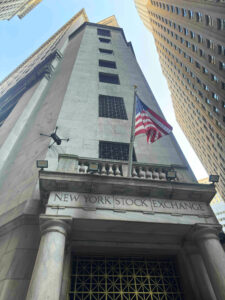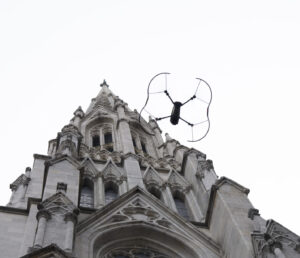Drone Building Inspection: What NYC Property Owners Need to Know in 2025
 In 2025, building inspections in New York City are more demanding than ever. Updated rules under Local Law 11 have raised expectations, increased penalties for non-compliance, and made the inspection process more complex and expensive. As a property owner, you now face more pressure to stay compliant, avoid safety risks, and manage costs. A drone building inspection can help you meet these challenges with speed, accuracy, and less disruption.
In 2025, building inspections in New York City are more demanding than ever. Updated rules under Local Law 11 have raised expectations, increased penalties for non-compliance, and made the inspection process more complex and expensive. As a property owner, you now face more pressure to stay compliant, avoid safety risks, and manage costs. A drone building inspection can help you meet these challenges with speed, accuracy, and less disruption.
At AeroSpect, we provide drone-based inspection services designed specifically for New York City buildings. We offer a better way to capture full façade data while working within city regulations. If you’re preparing for your next FISP cycle or need an alternative to scaffolding and wall drops, here’s what to know.
What’s Changed in NYC Building Inspections
The Façade Inspection and Safety Program (FISP), known as Local Law 11, now requires more detailed visual documentation and a higher level of professional oversight. Buildings over six stories must be inspected every five years. Inspectors—known as Qualified Exterior Wall Inspectors (QEWIs)—must now have seven years of experience instead of one.
More hands-on inspections are required too. QEWIs must perform physical “drops” every 60 feet, even if no visible damage is present. These changes aim to reduce accidents caused by deteriorating facades, but they also increase inspection costs and extend project timelines.
For property owners, this means you need a reliable way to meet these requirements without slowing down your operations. Drone building inspections offer a direct solution.
The Role of Drone Building Inspection in 2025 Compliance
Drone inspections help meet the city’s 100% façade coverage requirement without relying on scaffolding or swing stages. Our drones capture high-resolution images of the entire building surface. We then organize this visual data into a detailed façade map, making it easy for QEWIs to document their findings.
This method speeds up report preparation and creates a clear record for future reviews. With AeroSpect’s help, many QEWIs use drone data to decide where physical inspections are actually needed, avoiding unnecessary drops.
Our inspections also support long-term compliance. By keeping a full digital record of your building’s condition over time, you can track repairs, detect changes, and respond quickly to new issues.
What Property Owners Can Expect From an AeroSpect Inspection
When you hire AeroSpect, we keep the process simple. After receiving your building address and any elevation drawings, we schedule a drone flight. Our certified pilots collect geo-tagged, high-resolution images of the entire exterior. The data is processed offline and then uploaded to our secure Web Portal—or delivered via hard drive if you prefer offline access.
We include annotated façade maps with every inspection. These maps make it easy for QEWIs to add notes, mark areas of concern, and share findings with your team or other vendors.
For properties with flat rooftops or HVAC systems, we also offer optional LIDAR scans and aerial thermography. These advanced tools help identify structural shifts, moisture buildup, or insulation problems that might not be visible through regular photography.
Cost Comparison: Traditional Methods vs. Drone Alternatives
Traditional façade inspections in NYC require permits, scaffolding, and sidewalk protection. This can cost thousands of dollars and take days or weeks to arrange. It also disrupts building access and street traffic—especially in dense areas like Manhattan or Brooklyn.
A building inspection with drones removes those issues. We need no scaffolding, no sidewalk closures, and no suspended access. Our crews operate on the ground and complete most inspections in a matter of hours. This lowers your labor and permitting costs and avoids major scheduling delays.
Drones also reduce the number of physical drops required. By helping QEWIs target only the areas that need close review, we help you cut inspection costs without cutting corners.
Staying Ahead of Safety Issues Before They Escalate
 One of the most valuable parts of a drone building inspection is early detection. Our images show small cracks, gaps, or water stains that can turn into larger problems if ignored. By spotting these issues early, you reduce the risk of falling debris and expensive emergency repairs.
One of the most valuable parts of a drone building inspection is early detection. Our images show small cracks, gaps, or water stains that can turn into larger problems if ignored. By spotting these issues early, you reduce the risk of falling debris and expensive emergency repairs.
Drone documentation also gives you visual proof if a tenant raises concerns or if a legal issue arises later. You’ll have clear, time-stamped images showing your building’s condition at each inspection cycle. This is especially useful for insurance claims or litigation.
How AeroSpect Makes It Easy to Get Started
At AeroSpect, ’ve led the way in drone inspections across NYC since 2018. Our team includes FAA-licensed pilots and Level II thermographers. We’re fully authorized to operate in all five boroughs and carry $10 million in liability coverage.
To get started, all you need is your building location and any available elevation drawings. We’ll take care of the flight planning, data collection, and image delivery. If your QEWI has specific needs, we’ll coordinate with them directly.
We’re also available for urgent inspections, post-storm evaluations, or re-inspections tied to Local Law 11 filings.
Stay Compliant Without the Headache
Building owners in New York face more responsibility than ever when it comes to façade safety. But that doesn’t mean inspections have to be slow, expensive, or disruptive. A drone building inspection gives you the speed, accuracy, and documentation you need—without the extra equipment or delays.
If you’re preparing for a Local Law 11 deadline or want to explore a better way to inspect your building, contact AeroSpect. Email info@aerospectny.com or call 718-551-3363 to schedule a consultation or request a sample inspection. We’re ready to help you simplify compliance in 2025 and beyond.
